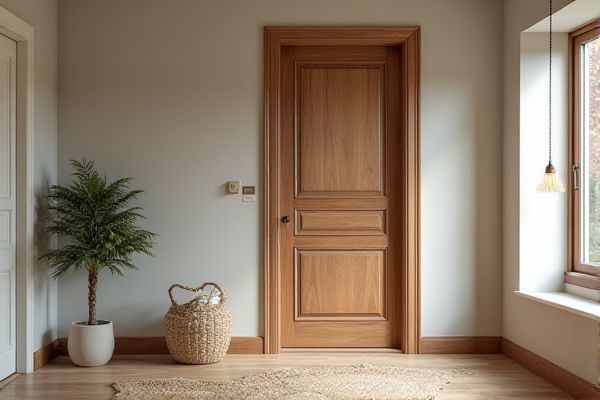
Inset doors fit flush within the cabinet frame, creating a clean and seamless look, while overlay doors cover the cabinet frame partially or entirely to offer a more traditional or contemporary style. Discover which door style suits Your design preferences and functional needs by reading the rest of the article.
Table of Comparison
| Feature | Inset Doors | Overlay Doors |
|---|---|---|
| Design Style | Flush, traditional, classic look | Modern, bold, seamless appearance |
| Installation | Sits inside the cabinet frame | Covers the cabinet frame edges |
| Space Efficiency | Requires precise measurements, less tolerant | Allows slight size variations, more forgiving |
| Hinges | Visible, requires special inset hinges | Usually concealed or standard hinges |
| Durability | More sensitive to warping and alignment | More robust and easier to repair |
| Cost | Typically higher due to precision | Generally more affordable |
| Common Use | Traditional kitchens, custom cabinetry | Contemporary kitchens, mass production |
Introduction to Inset and Overlay Doors
Inset doors fit flush within the cabinet frame, providing a sleek, seamless appearance that highlights traditional craftsmanship. Overlay doors cover the cabinet frame partially or fully, offering more design versatility and the ability to maximize cabinet interior space. Both styles influence the overall kitchen aesthetic and functionality, with inset doors emphasizing precision and overlay doors allowing for varied profiles and finishes.
Definition of Inset Doors
Inset doors are cabinet doors that fit flush inside the frame of the cabinet, creating a sleek and seamless appearance. Unlike overlay doors that cover the cabinet frame, inset doors sit within the frame, allowing the cabinet's structure to remain visible and accentuating fine craftsmanship. This precise fit requires meticulous construction and offers a timeless, traditional look often preferred in custom cabinetry.
Definition of Overlay Doors
Overlay doors are cabinet doors designed to cover the cabinet frame entirely or partially when closed, creating a sleek, seamless appearance. They come in full overlay and partial overlay styles, with full overlay doors covering most of the frame for a modern look and partial overlay doors exposing some of the frame for a traditional aesthetic. Overlay doors are preferred for their ability to maximize cabinet accessibility and enhance kitchen design versatility.
Key Differences Between Inset and Overlay Doors
Inset doors sit flush within the cabinet frame, offering a sleek, built-in appearance, while overlay doors cover the frame partially or fully, creating a more prominent, raised look. Your choice impacts cabinet style, hardware compatibility, and ease of installation, with inset doors requiring precise craftsmanship and overlay doors offering more design flexibility. Understanding these differences helps you select the best cabinet door for your kitchen's aesthetic and functional needs.
Aesthetic Considerations: Inset vs Overlay
Inset doors sit flush within the cabinet frame, offering a sleek, classic look that highlights craftsmanship and precision. Overlay doors cover the cabinet frame partially or fully, creating a seamless, modern appearance with varying degrees of frame exposure. Choosing between inset and overlay doors depends on desired visual style, with inset emphasizing traditional elegance and overlay supporting contemporary design trends.
Functional Pros and Cons
Inset doors sit flush within the cabinet frame, offering a sleek, traditional look and easy access but require precise installation and can be prone to sticking. Overlay doors cover the cabinet frame partially or fully, provide a modern appearance, and are easier to install, yet may reduce access space and show less detailed craftsmanship. Your choice depends on prioritizing either visual aesthetics or practical access in your kitchen design.
Cost Comparison of Inset and Overlay Doors
Inset doors typically cost more than overlay doors due to the precise craftsmanship required for their flush fit within the cabinet frame. Overlay doors are generally more budget-friendly because they cover the cabinet frame, allowing for easier installation and reduced manufacturing complexity. Your choice between inset and overlay doors should consider both aesthetic preferences and the cost variations linked to production and installation.
Installation and Maintenance Factors
Inset doors fit flush within the cabinet frame, requiring precise installation to ensure alignment and smooth operation, making the process more time-consuming and demanding skilled craftsmanship. Overlay doors attach on the cabinet face, offering easier and quicker installation with more forgiveness in measurements, reducing labor costs and adjustments. Maintenance of inset doors often involves adjusting hinges for perfect fit and clearing debris from the frame to maintain seamless closure, while overlay doors typically require less frequent adjustments due to their simpler mounting style.
Best Applications for Each Style
Inset doors are best suited for traditional and classic kitchen designs, offering a flush, built-in look ideal for showcasing craftsmanship and clean lines. Overlay doors, available in full, partial, or medium overlays, work well in contemporary and modern kitchens where maximizing cabinet space and ease of installation are priorities. Your choice depends on whether you value an elegant, tailored appearance with precise alignment (inset) or a cost-effective, versatile option that emphasizes cabinet accessibility (overlay).
Conclusion: Choosing the Right Door Type
Choosing between inset and overlay doors depends on kitchen style preference and functional needs. Inset doors offer a flush, traditional look with precise craftsmanship but require more maintenance. Overlay doors provide a modern, versatile appearance with easier installation and better cabinet space utilization.
 homyna.com
homyna.com